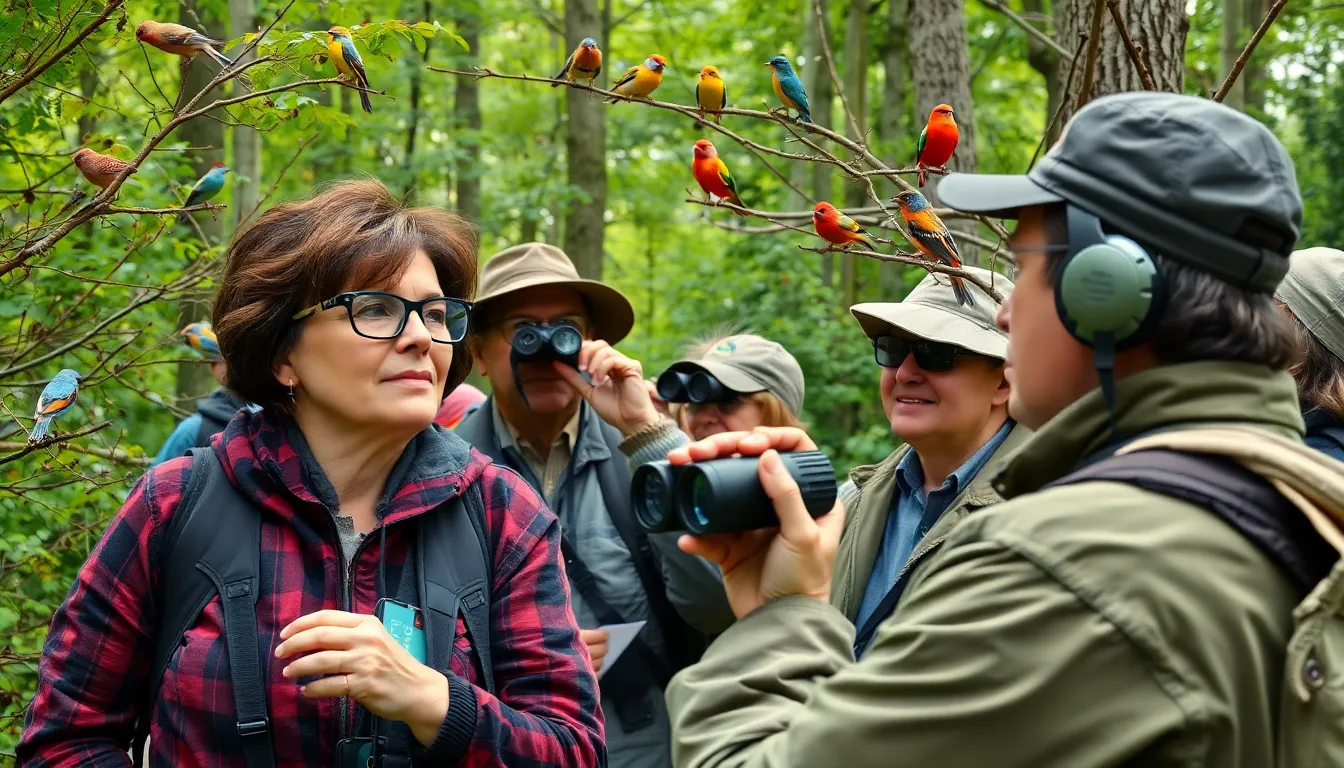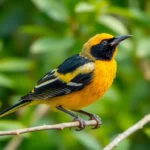Discovering the intriguing area of birds has never been more accessible than it is today. Whether you’re stepping into your backyard for the first time with binoculars in hand or you’ve been watching feathered friends for years, having the right bird guide can transform your entire experience from guessing games into confident identification.
We’ve all been there – spotting a beautiful bird and wondering what species we’re actually looking at. The right bird guide becomes your trusted companion, helping you identify everything from common backyard visitors to rare migratory species that’ll make your heart skip a beat.
Our comprehensive approach to bird guides covers everything you need to know about choosing the perfect field companion. We’ll walk you through the essential features that separate outstanding guides from mediocre ones, explore both traditional field guides and modern digital alternatives, and share insider tips that’ll help you maximize your birdwatching adventures. Let’s jump into the industry of avian identification tools that’ll elevate your birding game.
What Makes a Great Bird Guide
A superior bird guide combines comprehensive identification features with accurate geographical data and exceptional visual materials. These elements work together to create an indispensable resource for reliable bird identification in the field.
Field Marks and Identification Features
Field marks serve as the primary identification tools that separate one species from another through distinctive physical characteristics. Great bird guides highlight exact features like bill shape, wing patterns, tail length, and leg color with precise descriptions that eliminate guesswork during observations.
Size comparisons provide crucial context by relating unfamiliar species to common birds like robins, sparrows, or crows. Seasonal variations receive detailed coverage since many species display different plumages during breeding, winter, and juvenile stages that drastically alter their appearance.
Behavioral descriptions complement physical traits by documenting feeding habits, flight patterns, and social interactions. Top tier guides include vocalizations with phonetic spellings and rhythm patterns that help identify birds before visual contact occurs.
Range Maps and Habitat Information
Accurate range maps eliminate confusion by showing exactly where each species occurs during different seasons throughout the year. Quality guides use distinct colors and symbols to indicate breeding ranges, winter territories, migration routes, and year round residence areas.
Habitat preferences narrow down possibilities by describing exact environments where birds typically appear. Detailed guides specify elevation ranges, preferred vegetation types, water proximity requirements, and human modified landscapes that attract certain species.
Migration timing provides temporal context that prevents misidentification of vagrant species outside their normal occurrence windows. Comprehensive guides include arrival and departure dates for seasonal residents along with peak abundance periods.
Quality of Illustrations and Photography
Professional illustrations often surpass photographs for field identification because artists can emphasize diagnostic features and show multiple poses simultaneously. Superior guides feature artwork that accurately depicts size relationships, color variations, and subtle markings that distinguish similar species.
High resolution photographs complement illustrations by showing birds in natural settings with realistic lighting conditions. Quality guides include images of both sexes, various age classes, and subspecies variations when important differences exist between populations.
Consistent artistic style throughout the guide creates visual coherence that speeds up the identification process. Professional bird guide illustrations use standardized poses, similar lighting angles, and proportional scaling that allows direct comparisons between species on the same page.
Top Bird Guide Books for North America

We’ve evaluated dozens of bird identification guides to bring you three standout options that consistently deliver exceptional results for North American birdwatchers. Each guide offers unique strengths that cater to different identification preferences and skill levels.
Peterson Field Guide to Birds
Peterson’s iconic arrow system revolutionized bird identification when Roger Tory Peterson first introduced it in 1934. The guide uses distinctive black arrows pointing to key field marks that distinguish similar species from one another. This visual system helps birdwatchers focus immediately on critical identification features like bill shape, wing bars, or tail patterns.
Peterson’s compact 6×4 inch format fits easily into any backpack or jacket pocket without adding unnecessary weight during long birding expeditions. The guide covers 650+ North American bird species with streamlined illustrations that emphasize diagnostic features over artistic detail. Range maps appear directly opposite each species illustration for quick geographic reference.
The updated seventh edition incorporates recent taxonomic changes and includes QR codes linking to audio recordings of bird songs and calls. Peterson’s strength lies in its systematic approach to teaching identification skills rather than simply displaying pretty pictures.
Sibley Guide to Birds
David Allen Sibley’s comprehensive guide features 6,600+ detailed illustrations showing birds in multiple poses, plumages, and flight positions. Sibley personally created every illustration using a consistent artistic style that captures subtle variations in feather patterns, body postures, and seasonal changes.
The guide’s larger format (7.5×5 inches) accommodates more detailed artwork and extensive text descriptions covering behavior, habitat preferences, and voice characteristics. Sibley includes age and sex variations for each species, showing how birds appear throughout their life cycles and breeding seasons.
Sibley’s range maps use color coding to indicate breeding ranges, winter territories, year round presence, and migration routes with exceptional precision. The guide covers 810 North American species including regular vagrants and introduced populations. Sibley’s academic background in ornithology ensures scientific accuracy throughout the identification process.
National Geographic Field Guide to Birds
National Geographic’s guide combines stunning photography with detailed illustrations to provide multiple visual references for each species. The guide features over 4,000 photographs showing birds in natural settings alongside traditional field guide artwork.
The compact design (4.25×7.5 inches) balances portability with comprehensive coverage of 1,023 North American bird species. Each species account includes multiple images showing different plumages, poses, and behavioral contexts that photographers and artists captured in the field.
Range maps integrate seamlessly with species accounts using National Geographic’s signature cartographic expertise. The guide includes detailed habitat descriptions and migration timing information compiled from eBird data and citizen science observations. Voice descriptions accompany sonogram graphics that visually represent bird songs and calls for audio learners.
Regional vs. Comprehensive Bird Guides

Regional and comprehensive bird guides serve different purposes in the birding community. Understanding their distinct advantages helps birders select the most appropriate resource for their exact needs and geographic focus.
Benefits of Regional Guides
Regional bird guides concentrate exclusively on species found within exact geographic boundaries such as states provinces or ecological regions. These specialized resources typically feature 200-400 species compared to comprehensive guides that may include 800+ species.
Targeted species coverage eliminates confusion by excluding birds unlikely to appear in your area. Regional guides for the Pacific Northwest focus on species like Varied Thrushes and Steller’s Jays while omitting southeastern species such as Painted Buntings or Brown-headed Nuthatches.
Enhanced detail depth characterizes regional guides through expanded species accounts behavioral notes and seasonal occurrence patterns. The “Birds of Texas” guide provides 3-4 pages per species compared to single-page treatments in national guides.
Portability advantages make regional guides practical field companions. Most regional guides measure 5×7 inches and weigh under 2 pounds making them easier to carry during extended birding sessions.
Cost effectiveness represents another important benefit with regional guides typically priced 30-40% lower than comprehensive alternatives. State exact guides range from $15-25 while national guides cost $35-50.
Local expertise integration distinguishes regional guides through contributions from area ornithologists and birding clubs. These guides incorporate migration timing habitat preferences and abundance patterns exact to the region.
When to Choose Comprehensive Guides
Comprehensive bird guides become essential tools when birding activities extend beyond single regions or when building foundational identification skills. These resources cover entire continents or countries providing broader species coverage.
Multi-region travel requires comprehensive coverage for birders visiting diverse locations throughout the year. Traveling from Maine to Florida during migration seasons exposes birders to 600+ potential species that regional guides cannot adequately cover.
Vagrant species identification benefits from comprehensive guide inclusion since rare birds often appear outside their typical ranges. Regional guides exclude these uncommon visitors while comprehensive guides provide necessary identification support.
Educational foundation building favors comprehensive guides for beginning birders learning fundamental identification principles. These guides demonstrate size relationships behavioral patterns and habitat associations across entire bird families rather than regional subsets.
Reference library establishment makes comprehensive guides valuable permanent resources for serious birders. Single comprehensive guides replace multiple regional volumes while providing consistent illustration styles and identification approaches.
Migration corridor coverage particularly benefits from comprehensive guides during spring and fall movements. Major flyways such as the Central Flyway host species from breeding grounds in Alaska to wintering areas in South America requiring extensive geographic coverage for accurate identification.
Digital Bird Guides and Mobile Apps

Digital bird identification tools have revolutionized birdwatching by providing instant access to comprehensive databases, real-time identification assistance, and community-driven observations. These mobile applications complement traditional field guides while offering interactive features that enhance species identification in the field.
Merlin Bird ID
Merlin Bird ID stands as Cornell Lab of Ornithology’s flagship identification app, featuring four distinct identification methods that accommodate different observation scenarios. Photo ID analyzes uploaded images and suggests potential matches based on visible characteristics and location data. Sound ID identifies birds through their vocalizations using advanced machine learning algorithms that process recorded calls and songs. Bird ID uses a question-based approach where users input observed size, colors, behavior, and habitat to generate species possibilities. eBird integration provides real-time data about species recently observed in the user’s area, increasing identification accuracy through local sightings.
The app includes comprehensive species accounts with detailed information about appearance, sounds, behavior, and habitat preferences for over 10,000 species worldwide. High-quality photos showcase different plumages, ages, and seasonal variations for each species. Professional audio recordings demonstrate typical calls and songs with spectrograms that visualize sound patterns. Range maps display breeding, nonbreeding, and year-round distributions with migration timing data.
Offline functionality allows complete access to downloaded content without internet connectivity, making it ideal for remote birding locations. Users can save personal sightings with photos, audio recordings, and location data to build comprehensive birding records.
eBird Mobile App
eBird Mobile transforms bird observation into citizen science by enabling real-time data collection that contributes to the industry’s largest biodiversity database. The app records detailed checklists with species counts, breeding behaviors, and habitat observations that support global conservation efforts. Location services automatically capture GPS coordinates and suggest nearby birding hotspots based on community activity.
Real-time data displays recent observations from other birders in the area, revealing species presence and abundance patterns throughout different seasons. Rare bird alerts notify users when uncommon species appear within specified distances from their location. The app maintains comprehensive life lists, location lists, and year lists that track personal birding progress across multiple categories.
Integration with Merlin Bird ID provides seamless identification support while maintaining detailed observation records. Users access range maps, abundance charts, and seasonal occurrence data directly within their checklists. The platform connects birders globally through shared observations and collaborative monitoring efforts.
Bar charts visualize species frequency and timing patterns for any location, helping predict optimal birding opportunities throughout the year. Personal statistics track birding milestones including species totals, counties visited, and observation frequencies.
Audubon Bird Guide App
Audubon Bird Guide App combines National Audubon Society’s century of bird expertise with modern mobile technology to deliver comprehensive identification resources for 821 North American species. The app features multiple high-resolution photos for each species showing different angles, plumages, and behavioral poses captured by professional wildlife photographers. Detailed species accounts include information about identification features, similar species comparisons, habitat preferences, and conservation status.
Interactive range maps display seasonal distributions with climate change projections that show how species ranges may shift over the coming decades. Users can filter maps by season to understand migration patterns and breeding territories. The app includes over 3,200 sound recordings covering calls, songs, and other vocalizations with accompanying spectrograms.
Search functionality allows filtering by multiple criteria including size, color, habitat, region, and shape to narrow identification possibilities. The app maintains offline access to downloaded content, ensuring field usability without cellular connectivity. Personal features include customizable favorites lists, note-taking capabilities, and photo uploads for personal observations.
Regional customization displays species likely to occur in exact areas based on geographic location and seasonal timing. The app connects to eBird for additional sighting data and community observations in nearby locations.
Choosing the Right Bird Guide for Your Skill Level

Selecting a bird guide that matches your expertise level transforms birdwatching from overwhelming confusion into rewarding discovery. We recommend different resources based on your current identification skills and birding experience.
Beginner-Friendly Options
Starting with Peterson Field Guide to Birds gives new birders an accessible introduction to species identification. The iconic arrow system highlights crucial field marks without overwhelming first-time users with excessive detail. This guide’s 6×9 inch format fits comfortably in backpacks while covering 650 North American species.
National Geographic Field Guide to Birds combines stunning photography with clear descriptions that beginners find easier to interpret than complex illustrations. The guide presents multiple photos per species, showing seasonal variations and different poses that newcomers commonly encounter in the field. Its 768 pages organize species by habitat preference rather than taxonomic order, helping beginners locate birds they’ve observed in exact environments.
Digital options like Merlin Bird ID simplify identification through interactive features that traditional guides can’t offer. The app’s “What did you see?” function asks simple questions about size, color, and behavior to narrow down possibilities. Photo ID technology allows users to snap pictures of birds they can’t immediately identify, while the app provides instant suggestions with confidence ratings.
Pocket-sized regional guides focus on 150-200 local species, eliminating confusion that comprehensive guides create for newcomers. These condensed versions highlight the most common backyard birds and park species that beginners encounter during their first outings. Examples include “Birds of Eastern North America” for East Coast residents or “Common Birds of California” for West Coast beginners.
Advanced Birder Resources
The Sibley Guide to Birds delivers unparalleled detail through 6,600 original paintings that capture subtle variations experienced birders need for challenging identifications. Each illustration shows age variations, regional subspecies, and seasonal plumage changes that separate similar species. Advanced birders rely on this guide’s 544 pages to distinguish between confusing groups like female ducks or fall warblers.
Comprehensive field guides covering 900+ species serve experienced birders who travel across multiple regions or pursue vagrant species. These resources include detailed voice descriptions, flight patterns, and behavioral notes that advanced observers use to identify distant or partially obscured birds. Range maps in these guides show breeding, wintering, and migration routes with precision that experienced birders require for rare species documentation.
eBird Mobile transforms advanced birding into scientific contribution by recording observations that contribute to global biodiversity databases. The platform’s real-time alerts notify experienced birders about rare species in their area, while its extensive historical data helps plan birding trips to exact locations during optimal seasons. Advanced users access detailed abundance graphs and breeding phenology charts that guide their field efforts.
Specialized guides targeting exact bird families or challenging identification scenarios complement comprehensive resources for expert birders. Examples include “Hawks at a Distance” for raptor identification or “Warblers of the Americas” for detailed warbler study. These focused resources provide depth that general guides can’t match, featuring comparison plates and detailed molt sequences that advanced birders use for precise identifications.
Digital subscriptions to Birds of North America Online offer peer-reviewed species accounts with current research findings, nest descriptions, and ecological data that field guides omit due to space constraints. Advanced birders use these detailed life history accounts to predict bird behavior and locate hard-to-find species during exact breeding or migration periods.
Essential Features to Look for in a Bird Guide

Quality bird guides share exact characteristics that enhance field identification and improve our overall birding experience. Understanding these features helps us select guides that match our exact needs and birding environments.
Size and Portability
Field guides come in three primary size categories that affect their practical use during birding expeditions. Pocket guides measure 4×6 inches and weigh under 8 ounces, making them ideal for long hiking trips and ultralight packing. Standard field guides typically measure 5×8 inches and weigh 12-16 ounces, providing the optimal balance between detail and portability for most birding situations. Large format guides measure 8×10 inches or larger and weigh over 20 ounces, offering extensive detail but requiring dedicated carrying answers like birding vests or backpacks.
Durability features significantly impact a guide’s longevity in outdoor conditions. Waterproof covers protect pages from rain and humidity, while reinforced binding prevents pages from separating during heavy use. Laminated reference pages resist tearing and allow easy cleaning after muddy or sandy encounters.
Seasonal Information
Comprehensive seasonal data transforms static identification into ever-changing understanding of bird behavior throughout the year. Migration timing charts indicate when exact species pass through different regions, helping us plan birding trips around peak activity periods. Breeding season information reveals when birds display distinctive plumage changes, territorial behaviors, and nesting activities that aid identification.
Seasonal range maps show how bird distributions shift throughout the year, distinguishing between breeding ranges, wintering areas, and migration corridors. These maps prevent confusion when encountering species outside their typical seasons in our local areas. Molting schedules explain plumage variations between seasons, particularly important for identifying waterfowl and shorebirds that undergo dramatic appearance changes.
Weather pattern correlations help predict bird movement and behavior, such as how cold fronts trigger warbler migrations or how storm systems concentrate seabirds near coastlines. This information enables us to time our birding activities for maximum species diversity and unusual sightings.
Audio Components
Sound identification capabilities expand our birding skills beyond visual recognition alone, particularly valuable in dense vegetation where birds remain hidden. Digital guides and apps provide high quality recordings of songs, calls, and alarm notes for each species, allowing us to learn vocalizations before field trips.
Spectrogram displays show visual representations of bird sounds, helping us understand frequency patterns and duration characteristics that distinguish similar species. These visual aids prove especially useful for identifying closely related species like Empidonax flycatchers or various warbler species with subtle vocal differences.
Interactive playback features let us practice species identification through audio quizzes and comparison tools. Some advanced guides include regional dialect variations, showing how the same species’ vocalizations change across different geographic areas. Dawn chorus guides organize species by typical singing times, helping us identify the sequence of birds that begin singing at different pre sunrise intervals.
Conclusion
We’ve explored the essential elements that make a bird guide truly valuable for both novice and experienced birders. Whether you prefer traditional field guides with their proven identification systems or embrace modern digital apps with interactive features your success depends on choosing the right tool for your exact needs and birding style.
The key is understanding that no single guide works perfectly for everyone. Regional guides excel for local exploration while comprehensive references support broader adventures. Digital apps offer real-time data and community features that enhance traditional field guides rather than replace them entirely.
Armed with this knowledge you’re ready to select the perfect bird guide combination that’ll transform your outdoor experiences. Remember that the best guide is simply the one you’ll actually use consistently in the field.
Frequently Asked Questions
What makes a great bird identification guide?
A great bird guide combines comprehensive identification features, accurate geographical data, and exceptional visual materials. Key elements include field marks highlighting distinctive physical characteristics, size comparisons with common birds, detailed behavioral descriptions, accurate range maps, and habitat information. High-quality illustrations and photographs are crucial, as professional artwork often provides better identification support than photographs alone.
What are the top bird guides for North America?
The three standout guides are the Peterson Field Guide to Birds (known for its iconic arrow system and portability), the Sibley Guide to Birds (praised for extensive illustrations and detailed life cycle variations), and the National Geographic Field Guide to Birds (combining stunning photography with traditional illustrations and detailed habitat information).
Should I choose a regional or comprehensive bird guide?
Regional guides focus on specific geographic areas, offering targeted coverage, enhanced detail, and better portability at lower cost. Comprehensive guides cover broader species ranges and are essential for travelers or those building foundational skills. Choose regional guides for local birding and comprehensive guides for travel or extensive reference needs.
What digital bird apps are recommended?
Top digital options include Merlin Bird ID (offering photo analysis, sound recognition, and offline functionality), eBird Mobile (for citizen science contributions and real-time rare species alerts), and Audubon Bird Guide App (featuring high-resolution photos, interactive maps, and sound recordings with offline access and customizable features).
How do I choose a bird guide based on my skill level?
Beginners should choose user-friendly options like Peterson Field Guide or National Geographic Field Guide for simplified identification. Advanced birders benefit from the detailed Sibley Guide, specialized guides, and digital subscriptions. The eBird Mobile app helps expert birders contribute to research and receive rare species alerts.
What physical features should I look for in a field guide?
Consider size (pocket, standard, or large format based on birding needs), durability features like waterproof covers and reinforced bindings for outdoor use, seasonal information including migration timing and breeding behaviors, and audio components for sound identification capabilities, especially in digital formats.











